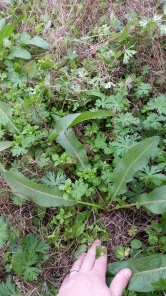
A relative of buckwheat (the plant not the rascal), Curly Dock (Rumex crispus) is an easy to identify wild edible that occurs across most of the United States. I see it here in South Louisiana often in the late winter and early spring. It is characterized by a large basal rosette with dark green leaves that have wavy or curly edges. Hence the common name”curly” dock.

Curly Dock is a relative of Buckwheat. “Ooo-Taaay?”
The stems and leaves can be mottled with pinkish splotches at times. Usually the pink tinge shows up in the older, tougher leaves, so many times you want to avoid them altogether.
It being a relative of buckwheat, it’s no surprise that once it warms up enough, it will send up a stalk containing hundreds of little seeds that are also edible. You simply place a paper bag over the dark brown to brownish red seed stalk, and shake like Beyonce in an Earth quake. The seeds and husks once dried can be pound or ground into flour that looks much like buckwheat flour, and used for a variety of items. If you want to see how to make flour out of the seeds, check out this article.
I never bother collecting the seeds, but I do on occasion pick a few of the new growth leaves to boil in several changes of water along with other greens collected this time of year. I always boil them in a few changes of water to leach out the oxalic acid before adding it in with my other greens. I cook them like I would collard or mustard greens. The older leaves will be tough and bitter, so select the young tender guys. The young leaves that are just unfurling are the most tender. They put off a slimy like substance, but don’t worry because that just means that they aren’t dry and tough. That slimy substance can be used to rid your skin of the itching and burning sensation from stinging nettle, which tends to grow in similar locations and times of year.

New unfurling center leaf wrapped in a paper like sheath is a tell tale sign that this is Rumex crispus
Word to the wise, many consider this plant toxic to livestock (bovine and equestrian), and the seeds are toxic to poultry. So if you’ve got a farm, remove it and make good use of it by eating it yourself. Because of this, it is considered an invasive species in many parts of the U.S. This plant is not my favorite, but on occasion I will add it to a pot of greens as an add-on, but never as the primary part of the meal.
The first time you try curly dock you should only consume a very small amount, and wait 24 hours to see how it goes. In some people it has a slight laxative effect (which means that they can sometimes cause people to crap like a well lubed goose). I’ve heard that you can eat the young and tender leaves raw, but I’ve never done this as it is slimy, and seems like it would be harsh on the system. I’m into roughage, but not punishment! I cook these greens like I would collards, or mustard greens, removing the center rib from the larger leaves, and cooking the tender leaf parts.
You will find curly dock across most of the United States. I see it most frequently in fallow as well as planted fields, in pastures, even in lawns, and construction sites. This stuff will grow anywhere that it is allowed to take root. It is a very hardy plant with a deep taproot that has been used for a variety of things including treating anemia due to its iron content. It also puts off an extreme amount of seeds per plant, so they tend to spread like a yawn in church.
There you have it…Curly Dock, Rumex crispus. Booyah!
AS WITH ANY OF THE INFORMATION CONTAINED ON THIS WEBSITE, DO NOT USE THE INFORMATION CONTAINED HEREIN FOR IDENTIFICATION OF ANY WILD PLANT OR OTHER MATERIAL. IT IS FOR ENTERTAINMENT PURPOSES ONLY, AND YOU SHOULD CONSULT WITH A QUALIFIED EXPERT BEFORE YOU CONSUME ANY PART OF A WILD PLANT. A MISTAKE CAN BE FATAL. DON’T BE A MORON.
DON’T CONSUME ANYTHING TO TREAT THE BODY IN ANY WAY WITHOUT FIRST CONSULTING WITH A PHYSICIAN. AGAIN, DON’T BE A MORON.


Leave a comment